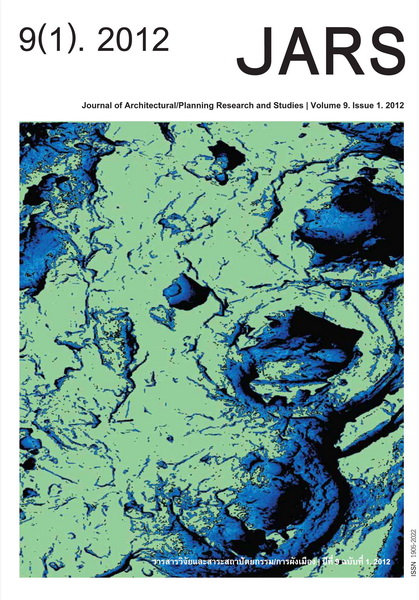The Changing Cultural Landscape of a Lao Song Community in a New Context: A Case Study of Pahaew
Main Article Content
Abstract
When Lao Song people migrated from their homeland in Vietnam to Thailand, they adjusted their lifestyle according to the predominant culture of the new society. These adjustments also changed their cultural landscape. This study explores the cultural transformation of the Lao Song’s burial ground or Pahaew. The Lao Song community at Ban Nong Prong, Phetchaburi Province was used as a case study. Unstructured in-depth interviews with a conservation leader and funeral director in the Lao Song community were conducted to obtain descriptions of the changes in the cultural landscape. A review of documents related to the history and observations of the area were carried out to compare the past and present conditions in the community. The results show that nowadays, the community uses Pahaew as a multipurpose area, rather than an area exclusively for religious worship, as in the past. The study concludes that cultural adaptation has transformed the Lao Song community’s beliefs, environment and social structure. These changes in turn have caused the modification of Pahaew in terms of its role, physical characteristics and function.
Downloads
Article Details

This work is licensed under a Creative Commons Attribution-NonCommercial-NoDerivatives 4.0 International License.
All material is licensed under the terms of the Creative Commons Attribution 4.0 International (CC-BY-NC-ND 4.0) License, unless otherwise stated. As such, authors are free to share, copy, and redistribute the material in any medium or format. The authors must give appropriate credit, provide a link to the license, and indicate if changes were made. The authors may do so in any reasonable manner, but not in any way that suggests the licensor endorses you or your use. The authors may not use the material for commercial purposes. If the authors remix, transform, or build upon the material, they may not distribute the modified material, unless permission is obtained from JARS. Final, accepted versions of the paper may be posted on third party repositories, provided appropriate acknowledgement to the original source is clearly noted.
References
Inpuntung, V., Chotima, C., Panin, O., & Kasemsuk, A. (2006). รายงานวิจัยฉบับสมบูรณ์โลกของชาวไทดำ: ความสัมพันธ์ซึ่งกันระหว่างสภาพแวดล้อมที่อยู่อาศัยของชาวไทดำในไทยกับในเวียดนาม [Final report: A relationship between dwelling environment of Tai Dum in Thailand and Vietnam]. Bangkok, Thailand: Faculty of Architecture Silpakorn University.
Inpuntung, V. (2010). การกลายรูปในเรือนลาวโซ่ง [Transformation of Lao Songs Houses]. First years progress report of holistic study for the adaptability in different context of Tai-Lao ethnic in the central region basin of Thailand. Bangkok, Thailand: 21 Century.
Ministry of Culture, Office of The National Culture Commission & Faculty of Architecture Silpakorn University. (2006). แนวทางการจัดการภูมิทัศน์วัฒนธรรม [Cultural landscape management]. Bangkok, Thailand: Amarin Printing and Publishing Public.
Panin, O., et al. (2008). เรือนพื้นถิ่นไทย-ไท [Thai-Tai vernacular house]. Bangkok, Thailand: Faculty of Architecture Silpakorn.
Panin, T., Jittirattanakorn, J., Ratanasupa, O., & Karnchanaporn, J. (2005). คติความเชื่อและระบบสังคมซึ่งสัมพันธ์กับเรือนและการอยู่ [Beliefs and social aspects in relation to house and living]. Bangkok, Thailand: Faculty of Architecture Silpakorn University.
Pitiphat, S. (2002). ศาสนาและความเชื่อไทดำในสิบสองจุไท สาธารณรัฐสังคมนิยมเวียดนาม [Religious and Beliefs of Tai Dam in Sib Song Ju Tai]. Bangkok, Thailand: The Thai Khadi Research Institute Thammasat University.
Pitiphat, S., et al. (2008). ไทดำ ไทขาว ไทแดง และไทเหลือง: อัตลักษณ์เปิด อัตลักษณ์ปิด [Tai Dam, Tai Khao, Tai Daeng and Thai Lueng: Opened-hidden identity]. Kasetsiri, C. (Ed.). Bangkok, Thailand: The Foundation for the Promotion of Social and Humanities Textbooks Project.
Punpairoj, P. (2011). ไทดำรำพันถึงเรือนกระดองเต่า: จากขุนเขาเมืองแถงสู่ลุ่มน้ำภาคกลางของไทย [Tai tortoise shaped houses: From the highlands of Muang Thaeng to the river basins of Thailand]. Journal of Architectural/Planning Research and Studies, 8(1), 21-34.
Samantarat, S., Tangkitngamwong, O., Limthongsakul., & Charoenchai, O. (2007). รายงานวิจัยฉบับสมบูรณ์ภูมิทัศน์วัฒนธรรมลุ่มนํ้าเพชรบุรี [Final report: Cultural landscape in Phetchaburi Basin]. Bangkok, Thailand: Kasetsart University.
Suebareepong, P. (2009). โซ่งดอนมะนาว: วิถีชีวิตชุมชนไทยทรงดำบ้านดอนมะนาว อำเภอสองพี่น้อง จังหวัดสุพรรณบุรี. [Song Don Manao: A lifestyle of Thai Song Dum community of Don Manao village, Song Peenong district, Suphanburi province]. Nakornpathom: Phetkasem Printing Group.
Yimrewat, P. (2001). ประวัติศาสตร์สิบสองจุไท [History of Sib Song Ju Tai]. Bangkok, Thailand: Sangsan.

